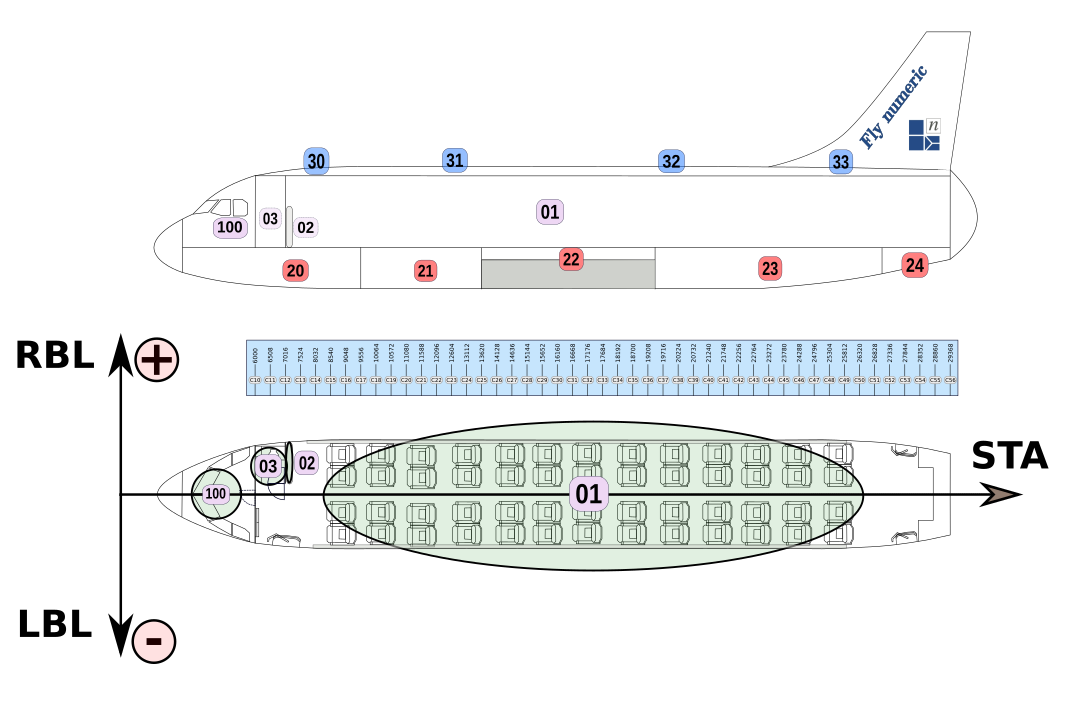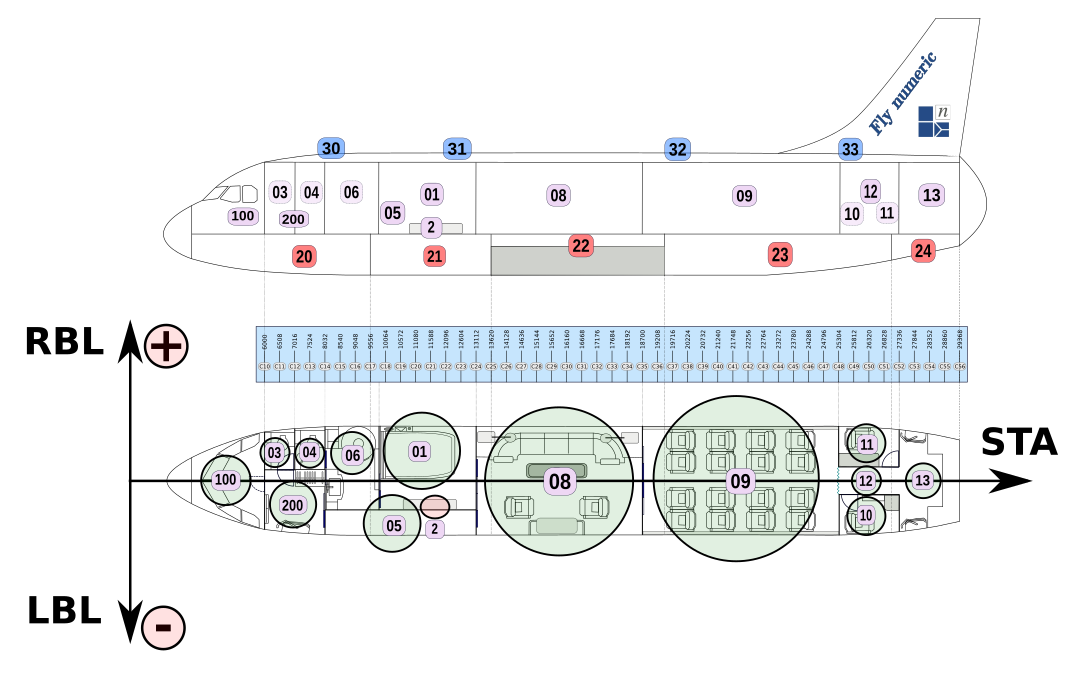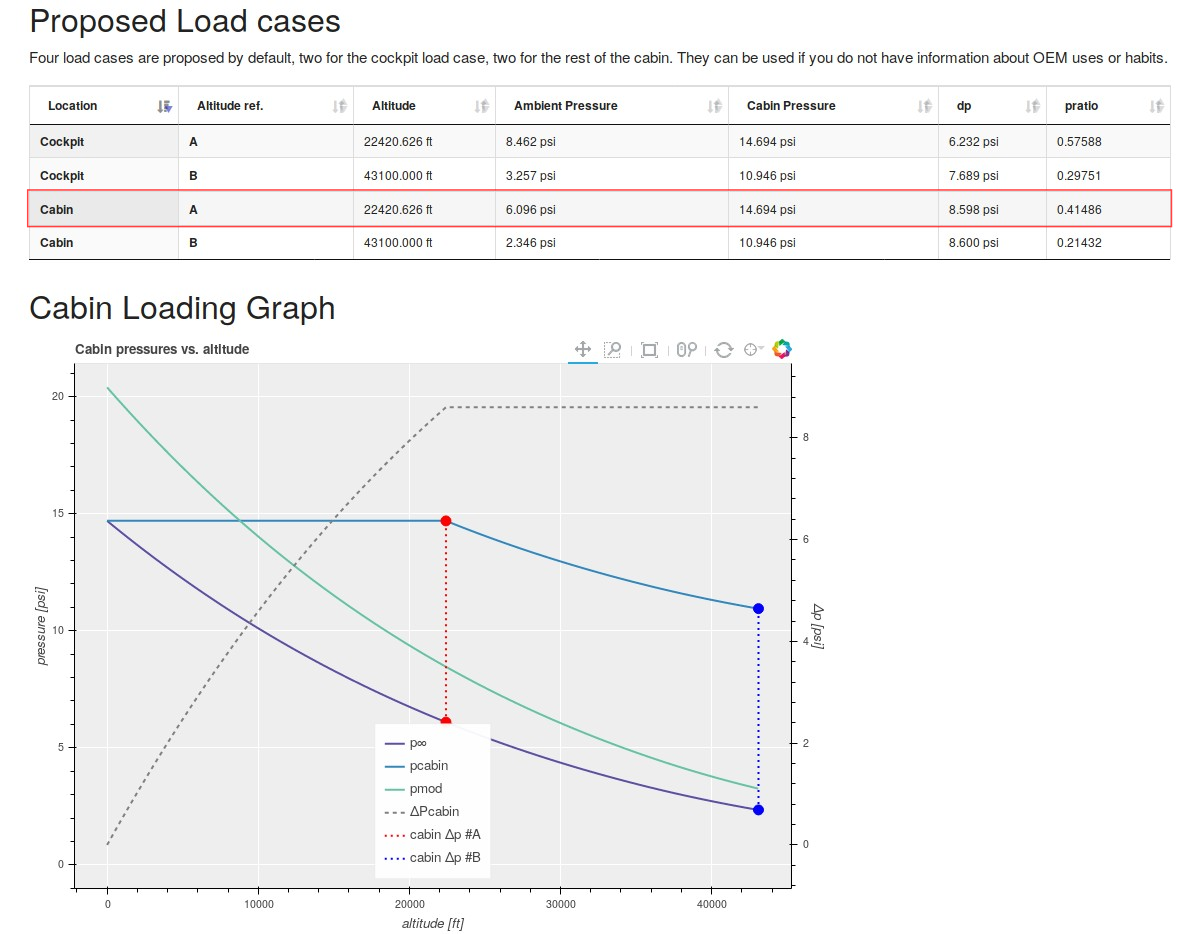Introduction
This article is the second one of a series dedicated to Small Volume Decompression (SVD).
The Article #1 was about determining the parameters influencing the differential pressure sustained by an enclosed volume (Cabinet, compartment, etc.) during an Aircraft depressurization event (Small Volume Decompression).
In the current article, we will present two configurations of the same dummy Aircraft that will be simulated and analysed to demonstrate the influence of the Aircraft interior Configuration on the differential pressure sustained by the enclosed volume. This dummy Aircraft — let’s call it Numeric Corporate Jet — will therefore be declined in an Airline/PAX configuration and a VIP configuration.
ESonix will be used to perform the decompression analysis.
Closed compartment in the Cabin Airline/PAX Configuration
The Airline/PAX Configuration of our Numeric Corporate Jet considers an entire Main Cabin (Vol#1), Toilet (Vol#3) and Cockpit (Vol#100) in the Main Deck. The Cabinet to be analysed as the closed-compartment (Vol#2) is installed inside the Main Cabin (Vol#1).
The Ceiling is divided in 4 volumes (Vol#30, Vol#31, Vol#32, Vol#33) which are connected to the Main Deck.
The Cargo Deck is divided in 5 volumes (Vol#20, Vol#21, Vol#22, Vol#23, Vol#24) which are also connected to the Main Deck.
The figure below illustrates the Numeric Corporate Jet in Airline/PAX Configuration considered in this study.

Closed Compartment in the Cabin VIP Configuration
The VIP Configuration of our Numeric Corporate Jet considers the Main Deck divided in several rooms (Vol#1, Vol#3, Vol#4, Vol#5, Vol#6, Vol#8, Vol#9, Vol#10, Vol#11, Vol#12, Vol#13) and Cockpit (Vol#100). The Cabinet to be analysed as the closed-compartment (Vol#2) is installed in inside the Bedroom (Vol#1).
The Ceiling is the same as per the Airline/PAX Configuration. It is divided in 4 volumes (Vol#30, Vol#31, Vol#32, Vol#33) which are connected to the Main Deck.
The Cargo Deck is also the same as per the Airline/PAX Configuration. It is divided in 5 volumes (Vol#20, Vol#21, Vol#22, vol#23, Vol#24) which are also connected to the Main Deck. A Cabinet, or Small Volume, (Vol#02) is installed in the Bedroom (Vol#1).
The figure below illustrates the Numeric Corporate Jet in VIP Configuration considered in this study.

Aircraft Parameters - Numeric Corporate Jet
As our Numeric Corporate Jet is a dummy model, the following aircraft parameters were adopted for both configurations Airline/PAX configuration and VIP configuration. They are:
1. Cabin Pressure, Atmospheric Pressure and ΔP
The Cabin Pressure (\(P_c\)) is the internal pressure of the Aircraft. It depends on other parameters as Flight Altitude, Relief Valve Settings, etc.
For the study of the Small Volume Decompression, the Cabin Pressure (\(P_c\)) that contributes to the most critical scenario of Aircraft decompression need to be determined. This \(P_c\) can be easily determined through the ESonix software tool called Aircraft Rapid Decompression Load Case Calculator
For this study, the following parameters are adopted for Numeric Corporate Jet:
- Maximum Flight altitude, ref.(1): 43‘100ft
- Airspeed limit, ref.(1): 0.89M
- Relief Valve Settings, ref.(2): 8.6psi
- Cabin Default pressure: 1 atm
- Pressure Coefficient: 0.7
The graph below, generated by ESonix tool, shows that the differential pressure ΔP increases with the altitude until it reaches the maximum ΔP (8.6psi maximum differential autorised in normal operation by the relief valve setting) — the isobaric mode —, around 22‘400ft. From this moment on, the \(\Delta_P\) is kept until the airplane reaches the maximum altitude — the constant differential mode —.
The maximum \(\Delta_P\) is the parameter that we are interested in, as it leads us to the critical decompression scenario we will run. The table below highlights the parameters that will be considered in this study (more explanations about the table and graph below will be available in a future post):
- Cabin Pressure: \(P_c\) = 14.694psi
- Atmospheric Pressure (3): \(P_a\) = 6.096psi
- Differential Pressure: \(\Delta_P\) of 8.6psi

2. Opening Hole
The Opening Hole, or opening in the fuselage taken into account for rapid decompression analysis, is defined by FAR 25.365(e), see also ESonix tool Calculate Opening Holes.
As per FAR 25.365(e):
\(HO = P \times AS\) , where:
- \(HO\) = Maximum opening, need not exceed 20 ft².
- \(AS\) = Maximum cross-sectional area of the pressurized shell [ft²]; and
- \(P = ( AS / 6240 ) + 0.024\) [in²]
The opening hole of Numeric Corporate Jet was determined, based on the its simulated dimensions, as 896 in² (6.22 ft²)
3. Thermodynamical Engines
Although ESonix presents four possibilities of thermodynamical engines (isentropic, isentropic_cddyn, polytropic, polytropic_cddyn), we selected the isentropic to be considered in this study.
4. Discharge Coefficients
The following Discharge Coefficients are adopted for both configurations:
| Connection | CD | Reference |
|---|---|---|
| Opening Hole | 0.5 | FAA AC25-20 |
| Between Small Volume and Main Cabin/Room | 0.6 | standard hole in wall discharge coefficient |
| Between Cargo Deck and Main Deck | 0.4 | low discharge coefficient due air flow turbulence |
| Between Ceiling and Main Deck | 0.6 | standard hole in wall discharge coefficient |
| Between Cockpit and Main Cabin/Room | 0.6 | standard hole in wall discharge coefficient |
NEXT STEP…
In the next Article we will show the details and results of the Small Volume Decompression analysis considering the Numeric Corporate Jet in the Airline/PAX Configuration.
See here the list of Articles referring to the study of Small Volume Decompression:
-
Article #1: Small Volumes Decompression #1 - Understanding the Problem
-
Article #2: Small Volumes Decompression #2 - Airline/Pax, VIP configurations and Aircraft Parameters
-
Article #3: Small Volumes Decompression #3 - Analysis of closed compartment in the Cabin Airline/PAX Configuration
-
Article #4: Small Volumes Decompression #4 - Analysis of closed compartment in the Cabin VIP Configuration
-
Article #5: Small Volumes Decompression #5 - Airline X VIP Results Comparison
-
Article #6: Small Volumes Decompression #6 - Airline X VIP Results Comparison (Further Step)
-
Article #7: Small Volumes Decompression #7 - Decompression Analysis considering the Cabinet Stiffness
-
Article #8: Small Volumes Decompression #8 - Study summary and conclusions